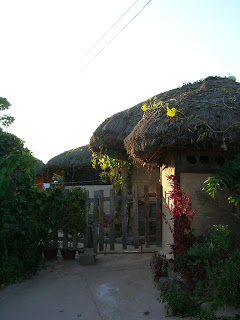We spent October 31 doing a particularly strange and spooky tour of the Demilitarized Zone (DMZ) between North and South Korea. We took a tour with an American company which was lead by Koreans for part of the way and American soldiers for the other part.
Not only were we able to go into the DMZ which stretches across the Korean peninsula and is 4km wide (2km on either side of the border where no Korean civilians are allowed), but also we were able to step foot on North Korean ground. Before entering the DMZ, we were given a Visitors Delcaration to read and sign, stating that we understood that we were "entering a hostile area and [there was a] possibility of injury or death as a direct result of enemy action." We had to follow a strict and conservative dress code, and we were warned more than once not to make any kind of gesture or body communication towards North Korea. We were taken right up to the actual line that divides the two worlds. On one side of the line stood South Korean and American soldiers on guard, and 50 feet away stood North Korean soldiers on guard. When we arrived to this area where North and South Korea both have buildings, we were taken into South Korea's Reunification Building, built for divided families to come and meet. However, this building was entirely vacant, and it has never been used save for the third floor in which the Red Cross has an office.
In this picture, you can see tourists, South Korean soldiers (in the black hardhats), American soldiers (in camo), and North Korean soldiers (taking pictures of us). You can also see the cement line that divides the Koreas. The building on the left is a conference room where meetings between N. Korea and the UN take place. Half is on N.Korean soil, and half on S.Korean. We were able to go into this building.

Before entering the building, a S. Korean soldier takes special measures checking the security of the room: locking the door into N. Korea, and standing guard the entire time visitors are present.

While in the conference room, North Korean soldiers came up near the windows to take pictures.

This guard is standing in a "modified Taekwondo stance" with half of his body behind the blue building. He is always on guard when visitors are there, and he stands in that position so that he can take quick cover if he needs to.

After leaving the dividing line, we were taken back out to the edge of the DMZ to a place where one of four tunnels into South Korea dug by North Korea have been discovered. We went down into the tunnel. Usually, when you do stuff like this, it's part of a history exhibit or something that is of the past. This is not of the past yet. Tourists are required to turn around and head back south about 170 meters from the border at the first of 3 barricades in place to keep North Koreans from entering South Korea. Soldiers expect that there are more tunnels being dug at this moment, but they don't know where yet.
We have limited pictures because of all the rules, but I think these give a pretty good idea of how intense the situation is. We even saw the world's most dangerous golf course!












